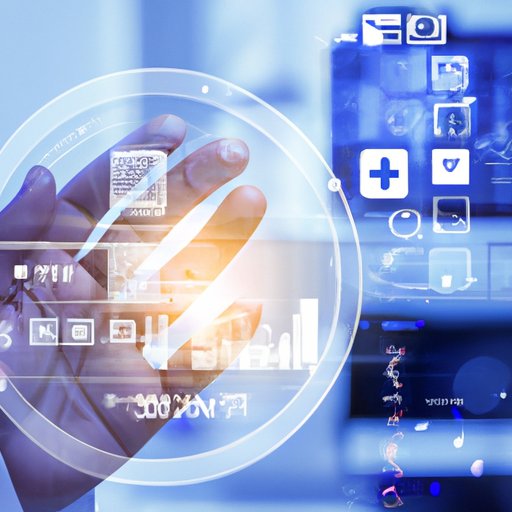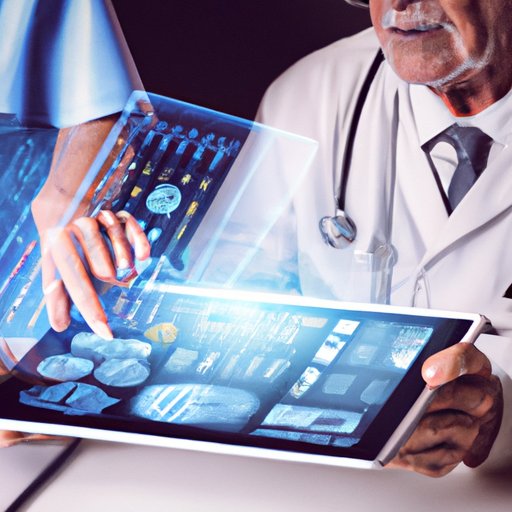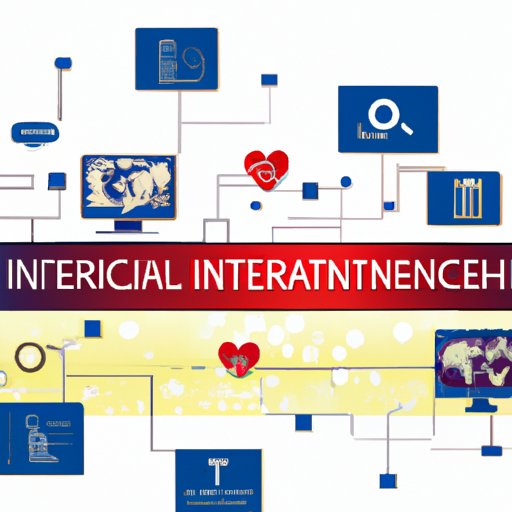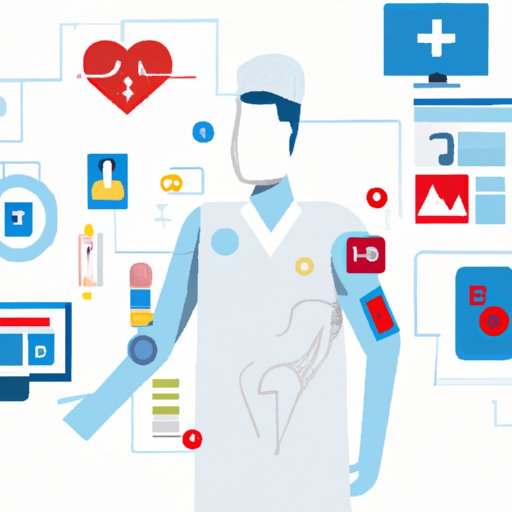Introduction
Medical information technology (MIT) is the use of computers, networks, software, hardware, and other technologies to store, share, and analyze healthcare data. It has revolutionized the way healthcare providers access, manage, and use patient data, leading to improved patient care, increased efficiency, and reduced costs. In this article, we explore the benefits, impact, and future developments of medical information technology in healthcare.
Exploring the Benefits of Medical Information Technology
The adoption of medical information technology has revolutionized the way healthcare providers manage data and deliver care. MIT offers a range of benefits, including improved patient care, increased efficiency, reduced costs, and improved data management.
Improved Patient Care
One of the primary benefits of medical information technology is improved patient care. By providing healthcare providers with quick and easy access to patient data, MIT enables more informed decision-making and better patient outcomes. For example, electronic health records (EHRs) provide healthcare providers with real-time access to patient history, medications, allergies, and other important information, allowing them to make more accurate diagnoses and provide more effective treatments.
Increased Efficiency
Medical information technology also increases the efficiency of healthcare delivery by automating processes that were once time-consuming and manual. For instance, the use of EHRs allows healthcare providers to quickly access patient data, reducing the time spent on paperwork and administrative tasks. This frees up time for providers to focus on delivering care, rather than paperwork.
Reduced Costs
The use of medical information technology also helps reduce healthcare costs. By automating processes and improving efficiency, MIT reduces labor costs and speeds up billing processes, resulting in lower overhead costs. Additionally, MIT can help reduce medical errors, which can lead to higher costs for healthcare providers.
Improved Data Management
Finally, medical information technology improves data management by providing healthcare providers with secure and centralized storage of patient data. This allows providers to quickly access and securely share patient data with other healthcare professionals, ensuring that all members of the care team have access to the most up-to-date information.

How Medical Information Technology is Transforming Healthcare
Medical information technology is transforming healthcare in a variety of ways, from automation of processes to improved communication. Here are some of the ways MIT is making an impact.
Automation of Processes
One of the most significant impacts of medical information technology is the automation of processes. By automating administrative tasks such as billing, scheduling, and documentation, MIT reduces the amount of time healthcare providers spend on paperwork and administrative tasks. This frees up time for providers to focus on delivering quality care.
Connected Devices and Systems
Medical information technology has also enabled the development of connected devices and systems, such as telemedicine and wearable technologies. These devices and systems allow healthcare providers to monitor patients remotely and provide timely interventions when needed. This improves access to care and enhances the quality of care.
Improved Communication
Finally, medical information technology has improved communication between healthcare providers and patients. Secure messaging systems enable healthcare providers to communicate with patients quickly and securely, while patient portals allow patients to access their medical records and communicate with their providers. This improved communication leads to better patient outcomes.
Exploring the Different Types of Medical Information Technology
There are a variety of different types of medical information technology, each with its own unique benefits. Here are some of the most commonly used types of MIT.
Electronic Health Records (EHRs)
Electronic health records (EHRs) are digital versions of patient charts that store patient data such as medical history, medications, allergies, lab results, and other pertinent information. EHRs provide healthcare providers with quick and easy access to patient data, enabling more informed decision-making and better patient outcomes.
Telemedicine
Telemedicine is the use of technology to provide remote healthcare services. It allows healthcare providers to diagnose and treat patients without the need for face-to-face visits. This improves access to care for patients in remote or underserved areas.
Wearable Technologies
Wearable technologies are devices that are worn on the body and transmit data to healthcare providers. These devices allow healthcare providers to monitor patients in real-time and intervene when necessary. This improves the quality of care and leads to better outcomes.

Examining the Impact of Medical Information Technology on Patient Care
The adoption of medical information technology has had a profound impact on patient care. Here are some of the ways MIT is improving patient outcomes.
Improved Access to Care
Medical information technology has improved access to care by allowing healthcare providers to diagnose and treat patients remotely. This is especially beneficial for patients in remote or underserved areas who may not have access to traditional healthcare services.
Enhanced Quality of Care
Medical information technology has also enhanced the quality of care by providing healthcare providers with quick and easy access to patient data. This enables more informed decision-making and better patient outcomes. Additionally, connected devices and systems allow healthcare providers to monitor patients in real-time, leading to timely interventions when needed.
Improved Outcomes
Finally, medical information technology has improved patient outcomes by enabling healthcare providers to provide more effective treatments. By providing healthcare providers with quick and easy access to patient data, MIT enables more informed decision-making and better patient outcomes.

Understanding the Challenges of Implementing Medical Information Technology
Although medical information technology offers numerous benefits, there are also a number of challenges associated with its implementation. Here are a few of the most common challenges.
Cost of Implementation
One of the primary challenges associated with the implementation of medical information technology is the cost. The cost of acquiring, implementing, and maintaining MIT can be prohibitively expensive for many healthcare organizations.
Security and Privacy Issues
Another challenge associated with the implementation of medical information technology is security and privacy issues. As more patient data is stored electronically, it is essential that appropriate measures are taken to ensure the security and privacy of this data.
Technological Barriers
In addition, technological barriers can pose a challenge. Healthcare organizations must invest in the necessary hardware, software, and infrastructure to ensure that their systems are up to date and capable of handling the demands of medical information technology.
Cultural Barriers
Finally, cultural barriers can also be a challenge. Healthcare providers must be willing to embrace new technology and adapt to the changing landscape of healthcare delivery.
The Future of Medical Information Technology in Healthcare
As medical information technology continues to evolve, new technologies are emerging that are transforming healthcare delivery. Here are some of the most promising developments.
Artificial Intelligence
Artificial intelligence (AI) is being used to automate processes, such as diagnosis and treatment planning. AI can help healthcare providers make more accurate diagnoses and provide more effective treatments.
Big Data
Big data analytics is being used to mine large datasets for insights into patient care and population health. This is helping healthcare providers identify trends, predict outcomes, and improve patient care.
Blockchain
Blockchain technology is being used to securely store and share patient data. This ensures that patient data is secure, private, and only accessible by authorized individuals.
Augmented Reality
Finally, augmented reality (AR) is being used to improve the patient experience. AR can be used to provide virtual tours of hospitals, immersive education experiences, and remote consultation capabilities.
Conclusion
Medical information technology has revolutionized the way healthcare providers access, manage, and use patient data. It offers a range of benefits, from improved patient care to increased efficiency and reduced costs. Additionally, MIT is transforming healthcare delivery through automation of processes, connected devices and systems, and improved communication. Finally, new technologies such as artificial intelligence, big data, blockchain, and augmented reality are emerging and will continue to shape the future of healthcare.
(Note: Is this article not meeting your expectations? Do you have knowledge or insights to share? Unlock new opportunities and expand your reach by joining our authors team. Click Registration to join us and share your expertise with our readers.)
